Édouard Manet (1832-1883) was a French painter who bridged the gap between Realism and Impressionism. In this post, I take a closer look at his life and art. I cover:
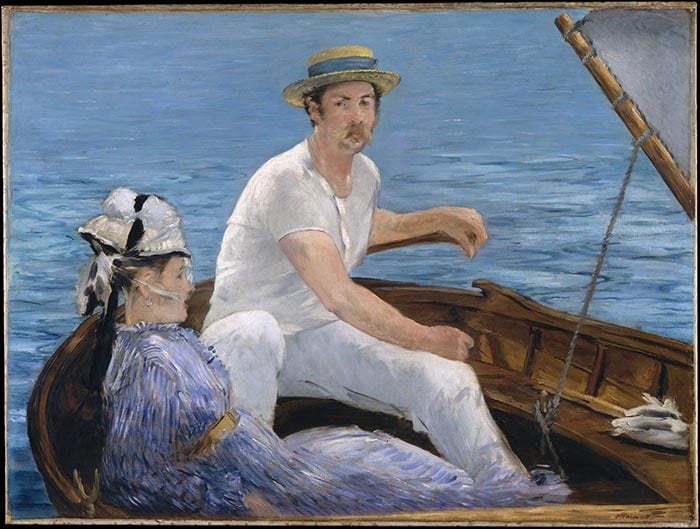
(Before diving into this post, make sure to pick up a copy of my free Landscape Painting Starter Kit.)
Key Facts
- Unlike many of his contemporaries, he was fortunate enough to be born into a wealthy family in Paris on 23 January 1832. His father was a high-ranking judge and his mother had strong political connections, being the daughter of a diplomat and goddaughter of Charles Bernadotte, a Swedish crown prince.
- His father expected him to follow in his footsteps down a career in law. However, with encouragement from his uncle, he was more interested in a career as a painter. His uncle would take him to the Louvre on numerous occasions to be inspired by the master paintings.
- Before committing himself to the arts, he tried to join the Navy but failed his entry examination twice. Only then did his father give his reluctant acceptance for him to become an artist.
- He trained under a skilled teacher and painter named Thomas Couture from 1850 to 1856. Below is one of Couture’s paintings, which is similar to the early work of Manet. I always find it interesting to see how much a teacher’s work can influence the work of their students. That is why you need to be selective with who you learn from.

- When he was not training with Couture, he would spend time at the Louvre copying the works of the Old Masters. He also traveled to Italy, Germany, and Holland from 1853 to 1856 to see works from masters such as Diego Velázquez, Francisco José de Goya, and Frans Hals. This is something that may have been prohibitively costly to those who had less fortunate upbringings.
- He ended up opening his own studio around the end of his studies in 1856.
- The Absinthe Drinker is the earliest recorded painting from Manet. It features a man named Collardet, who was an alcoholic who roamed around the Louvre in Paris. An empty bottle on the ground and a pale-green glass of absinth next to the man set the scene. You can see the influences of the Old Masters with the use of deep shadows and a reserved color palette. Manet submitted this painting to the Paris Salon in 1859, but it was rejected by the jury, perhaps due to its dramatic subject, or perhaps due to Manet’s technical limitations at the time. Manet would go on to become more refined in his technique and adopt a wider color palette.

- In 1861, he had two paintings accepted to the Salon: The Spanish Singer and Portrait of Monsieur and Madame Auguste Manet. The Spanish Singer was well received by the Salon and was placed in a prominent position. Compared to the tight and highly-rendered works of other artists selected for the exhibition, Manet’s work appeared fresh and slightly unrefined.

- Portrait of Monsieur and Madame Auguste Manet depicts Manet’s parents. His father had a stroke resulting in his loss of speech. Manet did a great job capturing the saddened and lost expressions on his parents’ faces. But notice the subtle differences between the two: his father appears stern with his hand clenched, whilst his mother appears tired, perhaps weighed down by the pressures of looking after her husband.

- Luncheon on the Grass was one of Manet’s most controversial works. He submitted it to the Salon in 1863, but it was rejected due to its provocative nature. Manet subsequently entered this and two other paintings in the first Salon des Refusés (which is French for the “exhibition of rejects”), which was established by Emperor Napoleon III after more than 2,000 artworks were rejected by the Salon jury. French journalist Émile Zola had some supportive and wise words for Manet’s painting:
“The Luncheon on the Grass is the greatest work of Édouard Manet, one in which he realizes the dream of all painters: to place figures of natural grandeur in a landscape. We know the power with which he vanquished this difficulty. There are some leaves, some tree trunks, and, in the background, a river in which a chemise-wearing woman bathes; in the foreground, two young men are seated across from a second woman who has just exited the water and who dries her naked skin in the open air. This nude woman has scandalized the public, who see only her in the canvas. My God! What indecency: a woman without the slightest covering between two clothed men! That has never been seen. And this belief is a gross error, for in the Louvre there are more than fifty paintings in which are found mixes of persons clothed and nude. But no one goes to the Louvre to be scandalized.” (Source)

- In 1870, he served as a soldier in the Franco-German War. His studio was partially destroyed in the war, but the remains and surviving works were purchased by art dealer Paul Durand-Ruel for 50,000 francs.
- His painting Spring sold for US $65.1 million to the J. Paul Getty Museum in 2014. On an interesting side note, there is a documentary out on the Getty family which I recently started watching by coincidence named Trust. I come across the Getty name frequently when writing about famous paintings. It is on Foxtel Now for those interested.

- He passed away from illness in April 1883. His legacy includes around 430 oil paintings, 89 pastels, and over 400 other works on paper.
A Closer Look at Manet’s Paintings
I take a closer look at some more of Manet’s notable paintings below, starting with Claude Monet Painting in His Studio.
Manet was friends with many of the top Impressionists including Claude Monet, Edgar Degas, Pierre-Auguste Renoir, Alfred Sisley, Paul Cézanne, Camille Pissarro, and Berthe Morisot. His painting of Monet below is appropriately impressionistic, with broken color, loose strokes, and vague detail. Monet is pictured on a boat, perhaps with his wife, painting the surrounding landscape.

Below is a portrait of another famous artist, Berthe Morisot, painted with a conservative palette of grays and browns. Notice how distinct the lights and darks are; Manet made little effort to ease the transition between the two areas.

Manet was particularly skilled at painting dormant expressions, like that in the painting below. Many of his paintings have a mystique of “what is the subject thinking?”
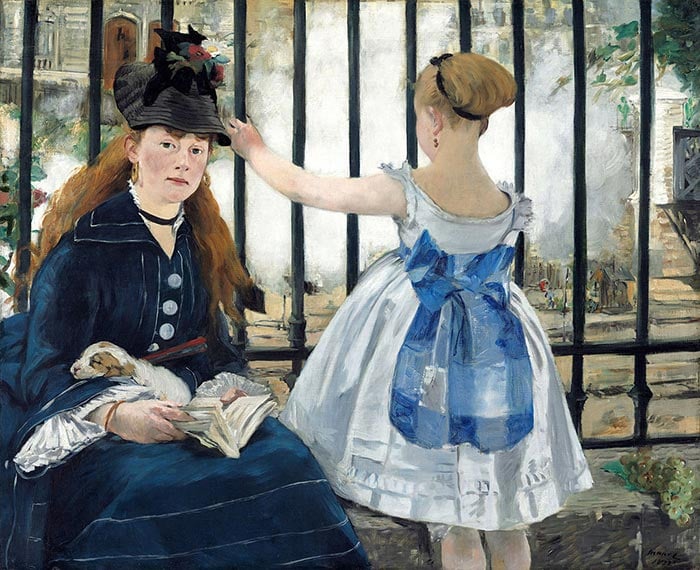
In The Plum or Plum Brandy, a lady stares vacantly off into the distance as she holds an unlit cigarette. In front of her rests her plum soaked in brandy, after which the painting is named. The lady appears soft and fragile, with the pastel colors contrasting against the more dramatic colors in the background. The subtle use of outlining also gives the painting a stylized feel, typical of Manet’s later work.

Manet took an Expressionist approach in the painting below, depicting the execution of Emperor Maximilian. There is a misty haze as smoke from the guns fills the air. The shooters are left faceless and appear in vast numbers. This work perhaps deserves a mention on my post about dramatic paintings.
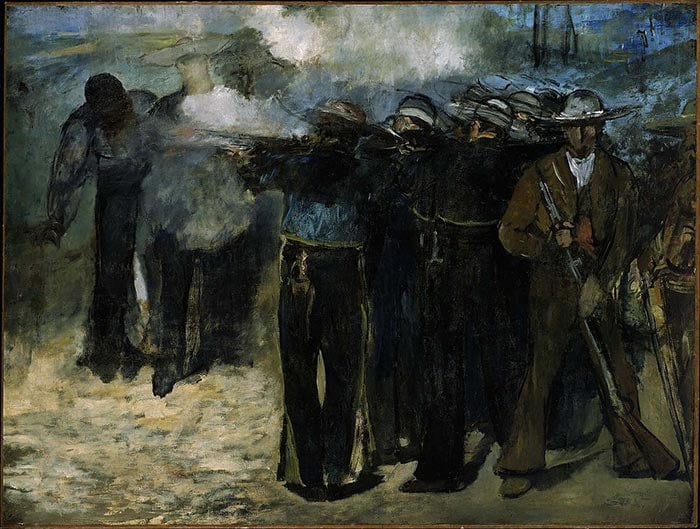
I love Manet’s use of color and brushwork in the painting below. You get a sense of the fleeting and busy nature of the scene, as people drink, smoke, and enjoy the concert. However, on the left-hand side of the painting is a dormant and saddened face. A cigarette in her hand and beer in front, she stares vacantly ahead, uninterested by the entertainment. What amazes me is how well Manet captured her emotions with such loose and unrefined brushwork.

Olympia is one of Manet’s most famous works which was exhibited at the 1865 Paris Salon. It depicts “Olympia” resting nude on the bed as a servant brings her flowers.
The painting was met with controversy when it was first exhibited at the Salon in 1865, not so much for the nudity of Olympia, but for her confrontational gaze and the suggestions in the painting that she may be a prostitute. The term “Olympia” was associated with prostitutes at the time and there are several hints at her sexuality and wealth (her hair, bracelet, earrings, the black ribbon around her neck, and the elegant bed cover).
French journalist Émile Zola had some harsh words to say about the painting and the nude lady:
“When our artists give us Venuses, they correct nature, they lie. Édouard Manet asked himself why lie, why not tell the truth; he introduced us to Olympia, this fille of our time, whom you meet on the sidewalks.”
The harsh reception demonstrates the conservative and often cruel nature of society at the time. People were more offended by the confrontational gaze of Olympia than the idea of the servent in the background.


Below is another one of Manet’s more impressionistic works. Out of all the artists I have written about, Manet certainly has one of the largest ranges in style, whilst still retaining an element of consistency throughout his work.

The painting below is remarkably complex, featuring a lady behind the bar, a background full of patrons, and many bottles and wines in the foreground. Manet goes back to that vacant expression for that lady behind the bar which he used in so many of his paintings. Notice how Manet used increased color, clarity, and contrast to bring the lady and bar in front of her forward in perspective. Everything else, including the lady with her back turned, appears more distant and hazy.

Want to Learn More?
You might be interested in my Painting Academy course. I’ll walk you through the time-tested fundamentals of painting. It’s perfect for absolute beginner to intermediate painters.
Thanks for Reading!
I appreciate you taking the time to read this post and I hope you found it helpful. Feel free to share it with friends.
Happy painting!
Dan Scott

Draw Paint Academy

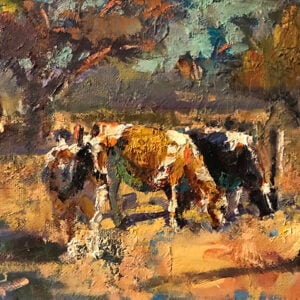

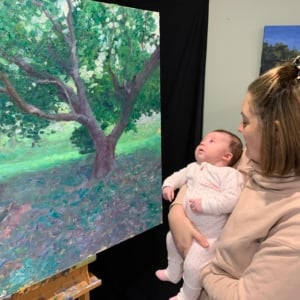
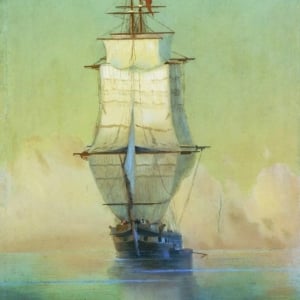
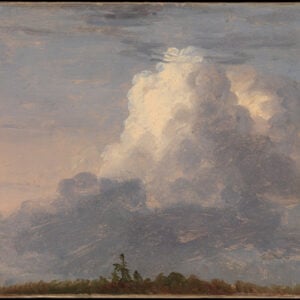
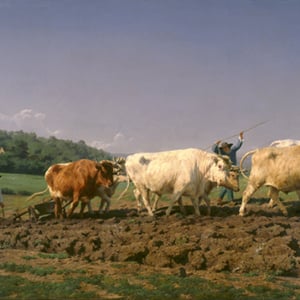
Surely the “the lady with her back” is just the bar maids reflection in the mirror and not another woman!
I agree and the patrons are reflecting as well
The man who the reflected woman in the mirror doesn’t make sense but, I do think it is a mirror behind the woman in the forefront.
I don’t think there was a mirror because all the angles are off. Let me give you an example of what I see. Look at the the bottles next to the front view lady’s right wrist. Do you see how closely they are to the wrist ? Now, look at where the bottles are to the lady who’s back is showing. If this were a mirror, those bottles would be exactly where they are in relation to the front facing lady…..just reversed. Now look at how the front lady is facing. Directly in front of the artist’s view. If there were a mirror behind her, it would not be so big of a distance showing between her and her reflection. Make sense?
Thank you Dan. You constantly amaze me at all the different artists you have shared with us.
I’m inclined to agree with you Debbie. To me it looks like a balcony behind the lady in the front. Also, did you notice the person just above the red bottle on the back table.. it looks like there is a person using binoculars..very interesting-lot of things going on.
Not sure I would tackle something that seems so complex.
Yes- also the woman in the background is leaning forward slightly while the woman facing the viewer is standing straighter.
Wow! I just had a read of all the comments. Very interesting. My initial interpretation was that it is a double sided bar and there is another woman serving on the other side. But now I am second guessing!
I found some interesting readings on the matter here:
http://www.getty.edu/art/exhibitions/manet_bar/looking_glass.html
https://en.wikipedia.org/wiki/A_Bar_at_the_Folies-Berg%C3%A8re#cite_note-OneScholar'sPerspective-3
These articles suggest it is a mirror reflection and that there is some optical trickery involved. In the first article, there is a photographic reproduction of the scene showing it is possible (yet still confusing for the viewer).
That is the great thing about art isn’t is? We can all look at the one painting and get many different interpretations of it.
Thanks everyone for taking the time to read and provide these very interesting comments!
Thank you for bringing the works of well know artists to our homes.
I thoroughly enjoy looking at the paintings and reading about them.
Thanks Dan, very interesting.
Thanks you i so enjoy your post
Thank you, enjoyed it
Grace
My husband always thought that was a reflection of the front-facing barmaid, but I don’t think she is in the right place for it to be a reflection; I just noticed that she is talking to a man,so based on those two things I am sure it is another woman, and not a reflection
I had just arrived at that conclusion, minutes before I read the comment by Janice Robinson… I totally agree with her. It is not a reflection.
Love reading these brief reviews on artists and their works that I probably would never know about. Thanks for broadening my horizon. Love it. Keep them coming.🎨🖌️
So much research you must have done! Thank you for such interesting information and all your effort in this post. Wonderful!
Thank you so much for every post you publish! I read every time with pleasure!!
Your posts including the lives of the artists give inspiration. It is always interesting to see how their status and training affect their work. Continuing to study through your Academy. Thank you.
oh , now I see it…not a reflection…interesting! Great article, I love the knowledge you bring us!
I absolutely Loved this post – thank you so much for this!
Love your comments! Than you so very much!
I think it is a mirror, look at the white shelf on which her hands rest, and you can see the frame of the mirror all the way across the painting just above the shelf. The man in the painting is not in view except for his reflection in the mirror, she is listening to him. The bottles on the white shelf are reflected back in the same colors and order.
I’ve read Wikipedia and even found a dissertation online about the mirror in the painting. EVERYTHING says it’s a reflection of the woman. But it can’t be because her reflection extends through the large frame of the mirror.
Took me back to Art history class in College.
As much as I try, I see the other woman to be a reflection. There is one bottle reflected on my left side and the look on her face is to the man seen reflected.
But thanks for the wonderful articles
thanks for this…brilliant !
I’ve found this painting intriguing since childhood when my parents had a record cover (back in the day) with a copy of this painting on the front. It seems like a mirror behind the woman at the bar , yet a couple of details aren’t quite right. The woman is leaning close to the man on the far right in the reflection- could this be Manet himself? But he is being served, not painting, and the main subject, the woman in the centre, is in a slightly different posture. I thought it’s going a painterly trick, meant to draw the viewer in – after all, art is a creation, not reality.
I’m loving all
Your posts
Thank you fr Nova Scotia Canada
Thank you Dan for this interesting article. I did not know too much about Manet, and now fortunate enough to read your article.
Also the Getty Museum, California, is featuring his work. I am going!
Manet and Modern Beauty
October 8, 2019–January 12, 2020
Thank you again!
Can’t tell you how much I enjoy and appreciate all the art blogs. You’ve introduced me not only to many great artists, but added all the paintings so I can learn about their work.
Loved this post and all the info and paintings! I look forward to your articles and read them top to bottom. I always learn so much!
Thank you so much. There was so much about Manet that I never knew. Quite enlightening. I love your stories, pls. keep them coming.
Although the reflection is not factual in a correct sense, it is one of the barmaid, and we are the gentleman. Manet’s signature was often to skew reality just slightly (witness the oversized bathing lady in ‘Luncheon on grass’. We are gazing at the barmaid, who in turn is not remotely interested in us but rather the crowd, who in turn is catching us in the reflection. A slice of distracted society.
I totally agree with Dolly’s, Barbara’ s and Mickie’s comments. Your research and sharing of the various artists’ backgrounds are informative, inspirational, and educational, as well as fun and interesting to read. I await your next posting, Monsieur Scott!
Thanks Dan.. As always, I enjoy reading your posts… Very informative.
The mirror question was controversial for years, but a reconstruction in 2000 showed how this was indeed likely to be a mirror behind the bar – possibly inspired by the complex and intriguing painting Las Meninas by Valazquez. For more details, read the “Painting” section of this Wikipedia article: https://en.m.wikipedia.org/wiki/A_Bar_at_the_Folies-Berg%C3%A8re
THANK YOU FOR THE MANET REVIEW.
THOROUGHLY ENJOYED AND LEARNED FROM IT.
Look forward to your emails and insights. Appreciate the lessons within each painting and the facts surrounding them. Makes me feel like painting every time I read your posts…thanks for always inspiring.
Jessica L DeFontes
Please continue to post this kind of information. very enjoyable and informative!
Thank you so much for sharing these.
Lovely paintings,
Thanks for sharing
Thank you Dan, I appreciate your posts! Beautiful Manet paintings! Imagine the talent required to generate controversy for centuries 🙂
What an interesting read! Manet certtainly inspired all kinds of emotions. I really do like his art work, even the slightly brazen renderings are artistically inspiring to me. Thank you so much for sharing your research!
Your posts are very interesting. I am a late starting painter and time is probably running out! Only watercolours so far. And very sporadic. I would be interested in your thoughts on Toller Cranston’s work, if that fits into your interests of course?
Greg
amazing article! breathtaking paintings..
I love these commentaries you send out! I read every word and study every picture. Such a help with my own art! Thank you so much.
Hi Dan,
What an insight to a very talented artist. Thanks for that. Very inspiring. Is it however possible to add the sizes of paintings. Warm regards from South Africa. Dalene Jacobs
There was a reconstruction of the bar scene in 2000, according to a wiki article (Google the painting name!) that demonstrated how the painting could indeed be a mirrored bar. In other words, you’re not the first or last person to have been initially confused by this painting, but you didn’t take your speculation as far as others have already.
This is fascinating…Thank you, Dan, for all the research and work that you put into these messages. The detail in the painting is daunting but you are helping me to notice things that are helping with composition constantly. Also, the comments that are left are great. I’m glad that I’ve returned to painting and glad I found your site. How about an oval balcony and a lady (in the same conservative dress of the period) speaking to the gentleman and in front of the balcony audience?) Why not?
Enjoyed looking at these pieces again and being able to zoom 🔎 right in on my mobile to pickup on the fine details, absorbing the depth of colour and light achieved. He certainly deserves the title of one of the greatest painters/Matters.
On another note… In the piece “A Bar at the Folies-Bergère, 1882” does anyone else see that the gentleman’s reflection in the right-hand corner is really out of proportion (even if he was meant to represent a larger man)?
Dan – I always appreciate your analyses of impressionist painters. It is far more interesting to me than Art History 201 ever was. In planning and doing my own paintings, I am challenged to have them present a “story”, narrate anything at all, or create an atmosphere. The classics, and the impressionists all had a lot going on (usually with people) in their paintings. Thanks for sharing your knowledge and research.
Dan,
I consider your posts my dessert for the day. I may not get to them immediately but when I do, it is a good refresher lesson or, something new. Reading all of the replies makes me feel the family of artists, or individuals who want to learn more about artists, are plentiful!’
Thank you and continue the good work.
Manet delved into illusion and realism throughout his paintings. Sometimes he gave his viewing audience stark realism with a nude painting such as Olympia staring straight at us the audience but well placed symbolism abounds but in another painting of nudes having lunch with fully dressed men , full erotic fantasy is on display. Manet used illusion and realism in the bar scene and the bar had a large wall mirror.
In addition, Manet painted the bar scene at the Folies Bergere when he was an older man dying of syphillis. That may or may not be a part of the distortion.
Read the Manet dissertation paper by Dr. Malcolm Park (2001 Australia) that states
it is a large mirrored reflection but truly at a distorted right angle as the top hatted man is peeking in from the right. Maybe that is Manet’s illusion of himself as a much younger self flirting with the barmaid. No one knows.
Thank you ! Dan, I enjoyed reading, observing and learning from this post..
It’s been many years since I have read much art history or analysis, so I am enjoying your articles so much. I took a class on Impressionism from the art historian, Dr. Wanda Corn, and wrote a paper on The Plum for her entitled, Manet’s Smoking Women. She loved it and sent to to her friend, art historian Eunice Lipton, at NYU who enjoyed my perspective. I discussed the changing roles of women in society depicted by Manet showing a scandalous woman smoking a cigarette, very atypical. I was not an art history major, but talked my way into Dr. Corn’s upper level class. She was a superb professor and I have had a lasting love affair with art ever since.